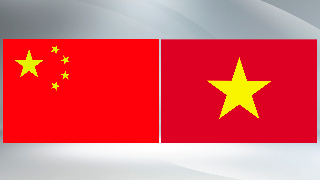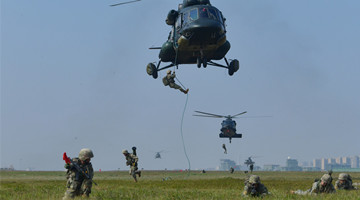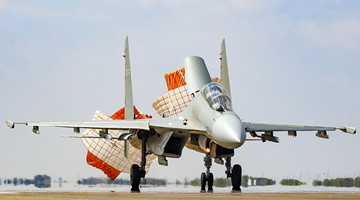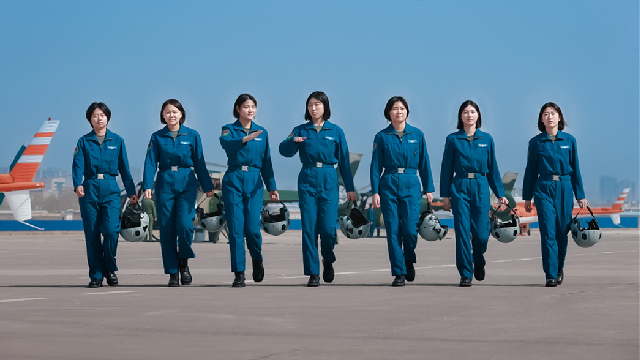
BEIJING, Jan. 10 (ChinaMil) -- A Chinese PLA Navy fleet led by the aircraft carrier Liaoning set sail for its first training in the year of 2018 without releasing any official information in advance.
The fleet's training information was instead unveiled by Taiwan. It disclosed on the afternoon of Jan 4 that the aircraft carrier Liaoning and several warships departed from their homeport and sailed past the Zhoushan island to carry out a long-range cross-sea training voyage.
It also confirmed the next day that the fleet, comprised of aircraft carrier Liaoning and two Type-052C guided-missile destroyers Zhengzhou (Hull 151) and Jinan (Hull 105) attached to the PLA Navy's East China Sea Fleet, had passed in the western part of Taiwan Strait.
There is no confirmation from mainland China’s military regarding the statements released by the Taiwan media and military. The only certainty is that on Jan. 4, the PLA Navy's official WeChat account released an article saying that a J-15 fighter jet started its training from the aircraft carrier Liaoning at 10:50 on the morning of Jan. 3, 2018.
Chinese military expert Li Jie said in an interview on Jan. 7 that the reason why the Chinese military did not make a high-profile announcement is that such kind of training has been normalized.
The aircraft carrier Liaoning fleet completed three cross-sea training at the end of 2013 and 2016, and in mid-2017. Sailing through the Taiwan Strait is familiar and easy to the fleet. The biggest difference between different stages of aircraft carrier Liaoning's cross-sea training is the different targets.
Li Jie believes that for different combat targets, the aircraft carrier Liaoning's training subjects in different voyages must be different. For example, some training voyages focus on land and sea combat operations while others focus on air defense.
Li also believes that the aircraft carrier fleet this time will use the Miyako Strait and the Bashi Channel to “go around” Taiwan again on its return trip.
Taiwan media quoted Taiwan military sources as saying that mainland China's aircraft carrier Liaoning is loaded with shipboard aircraft and carries the training personnel of China’s second aircraft carrier. Li Jie believes it is possible.
The aircraft carrier Liaoning is a research and training ship and therefore there may be some homegrown aircraft carrier personnel on board to learn from the Liaoning ship in preparation for the operation of the new carrier.
Recent Internet photos show that a large number of scaffoldings on China’s homegrown aircraft carrier have been removed. Li Jie believes that the sea trials of the new carrier will take place before and after the Spring Festival in 2018.
Recently, China's Central Military Commission (CMC) for the first time held a large-scale grand annual military training kicking-off ceremony. Against this backdrop, the training by the aircraft carrier Liaoning’s fleet must be "carried out under actual combat conditions."
Based on this, Li Jie believes that it is possible for the aircraft carrier Liaoning to launch night-time take-off and landing training in waters of the South China Sea.
It is impossible for the carrier-based aircraft to meet the requirements of "being able to combat and be victorious" without perfecting night time take-offs and landings. The carrier-based aircraft must eventually be able to complete combat missions under complex weather conditions at night. The relatively open sea and airspace of the South China Sea are more conducive to achieving this goal.
The South China Sea has no such limitation in airspace as those of the Yellow Sea and the Bohai Sea. The aircraft carrier Liaoning can reach the ideal speed in the vast sea area of South China Sea to provide better night-time landing conditions for shipboard aircraft.
Some analysts believe that the aircraft carrier Liaoning may have been at its maximum speed of 30 knots when sailing through the Taiwan Strait, and that sustained high speed is one of the core performances being tested. The high-speed deck wind is crucial for landings and take-offs of carrier-based aircraft.
Li believes that the speed does not have to be 30 knots and argues that 25 knots is enough. He said the sea conditions in the Taiwan Strait are rather complicated and for safety reasons it is unlikely that the aircraft carrier Liaoning fleet would proceed at 30 knots when sailing through Taiwan Strait.
Another professional analyst said that based on the time of the fleet’s entering and leaving the Taiwan Strait given by the Taiwan relative department, the fleet was not navigating at a high speed.
A fleet will sail at economic speed unless it is on a combat mission or has another specific purpose, said the analyst, adding that the aircraft carrier Liaoning fleet was on a long-distance cross-sea voyage and its fuel consumption would increase geometrically if at high speed.
The analyst stressed that the high-speed navigation of a large-scale naval fleet is also a military training course. In high-speed navigation, especially under complex sea conditions, the requirements for the power system and other relative aspects are at their highest, thus an aircraft carrier fleet may travel at the speed of 30 knots from time to time, but will definitely not in the whole voyage, the analyst added.









